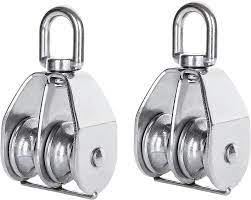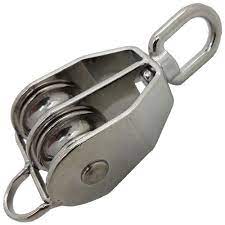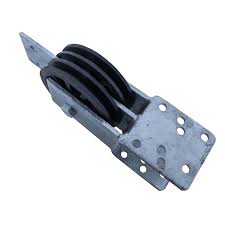Product Description
Stainless Steel SS304 Hardware Rigging wire rope rolling bearing block pulley
| Item | Wire Rope Pulley |
| Model | Single Pulley, Double Pulley |
| Size | M15-M100 |
| Material | Stainless Steel 304/316, Carbon Steel |
| Standard | DIN, ASME, BS, JIS, AS, EN, GB for option |
| Grade | A2-70, A4-80, 4.8/8.8 |
| Finish | Plain, Passivation, Polishing, Galvanized, Zinc Plated, Hot-dip Galvanized |
| Delivery Time | 3-15 days |
| OEM | Available |
Q: What’s your product range?
A: Our product cover Bolts, Screws, Nuts, Washers, Spring ,Rivet, Anchor, Pulley, Rigging and so on.
Q: How long is your delivery time?
A: 3 days for stock items,7-15 days for production.
Q: How do you control your quality.
A: QC on-line inspection and final inspection before delivery. 6S management. MTC and Quality Report can be provide.
Q: Could you provide free samples?
A: Yes, we could offer free samples for the items in stock, just need to pay shipping cost, it can be refunded to your orders.
Q: Do you accept small order?
A: Sure, we can accept small orders if we have stock of the specification which you need..
Q: What is your packing ?
A: 20-25kg for 1 carton,36 or 48 cartons for 1 pallet. One pallets is about 900-960kg. Customized carton and Customer’s logo is available.
Q: What is your payment term?
A: We can accept T/T, L/C for bulk order. Paypal and Western Union for small order or sample order.
Made-in-China Online payment is available.
Q: Do you accept customized order?
A: Yes, we can produce according to sample or drawing.
| Warranty: | 1 Year |
|---|---|
| Type: | Wire Rope Pulley |
| Material: | Stainless Steel/Carbon Steel |
| Number of sheaves: | Single Pulley, Double Pulley |
| Control: | Manual |
| Color: | Silver |
| Samples: |
US$ 0/Piece
1 Piece(Min.Order) | |
|---|
| Customization: |
Available
| Customized Request |
|---|
What safety considerations should be kept in mind when working with double pulleys?
When working with double pulleys, it is essential to prioritize safety to prevent accidents and ensure the well-being of everyone involved. Here are some important safety considerations to keep in mind:
1. Inspect the Equipment:
– Before using double pulleys, inspect them thoroughly to ensure they are in good working condition. Check for any signs of wear, damage, or corrosion. Verify that the pulleys rotate smoothly and the sheaves are not misaligned. Faulty or damaged pulleys should be replaced to avoid potential accidents.
2. Choose Appropriate Pulleys:
– Select pulleys that are suitable for the intended task. Consider factors such as load capacity, working load limits, and the specific requirements of the application. Ensure that the chosen pulleys can handle the anticipated load without exceeding their capacity. Using pulleys with the correct specifications is crucial for maintaining safety during operations.
3. Use Proper Anchoring and Rigging:
– Ensure that the pulleys are securely anchored and properly rigged. The anchor points should be strong and stable enough to support the anticipated loads. Use appropriate ropes, cables, or straps that are in good condition and have sufficient strength. Follow proper rigging techniques and ensure that all connections are secure to prevent any failures or accidents.
4. Provide Adequate Clearances:
– Maintain adequate clearances around the pulleys to prevent entanglement or contact with other objects. Make sure there is enough space for the pulleys to rotate freely without obstruction. Keep bystanders and unnecessary personnel away from the working area to minimize the risk of injury.
5. Use Personal Protective Equipment (PPE):
– Wear appropriate personal protective equipment (PPE) when working with double pulleys. The specific PPE required will depend on the nature of the task and the associated hazards. Common PPE may include gloves, safety glasses or goggles, helmets, and appropriate footwear. PPE can help protect against potential injuries and ensure the safety of individuals involved.
6. Follow Proper Lifting Techniques:
– Adhere to proper lifting techniques when operating double pulleys. Lift with your legs and not your back to avoid strain or injury. Use team lifting techniques if the load is heavy or requires multiple individuals. Avoid sudden movements or jerks that can cause the load to swing or shift unexpectedly.
7. Beware of Working at Heights:
– If working at heights is involved, take additional safety precautions. Ensure that the working platform or structure is secure and stable. Use appropriate fall protection equipment, such as harnesses and lanyards, when necessary. Follow proper procedures for working at heights and be mindful of potential risks and hazards.
8. Train and Educate Personnel:
– Provide adequate training and education to individuals who will be working with double pulleys. Ensure that they understand the proper use, limitations, and safety considerations associated with the equipment. Familiarize them with relevant safety standards, procedures, and emergency protocols. Ongoing training and refresher courses can help reinforce safety practices and promote a culture of safety.
9. Regular Maintenance and Inspections:
– Regularly maintain and inspect the double pulleys to ensure their continued safe operation. Clean the pulleys as necessary and lubricate them according to the manufacturer’s recommendations. Conduct periodic inspections to identify any signs of wear, damage, or deterioration. Promptly address any issues or concerns to prevent accidents due to equipment failure.
10. Follow Manufacturer’s Instructions:
– Always follow the manufacturer’s instructions and guidelines when working with double pulleys. Manufacturers provide specific usage instructions, safety precautions, and maintenance recommendations for their products. Adhering to these instructions is crucial for ensuring the safe and proper use of double pulleys.
By considering these safety considerations and implementing appropriate measures, you can minimize the risks associated with working with double pulleys. Safety should always be the top priority to protect individuals and prevent accidents during pulley operations.
What maintenance procedures are necessary to ensure the reliability of double pulleys?
Maintenance procedures are essential for ensuring the reliability and longevity of double pulleys. Proper maintenance helps identify and address any potential issues, prevents premature wear and tear, and ensures safe and efficient operation. Here is a detailed explanation of the maintenance procedures necessary to ensure the reliability of double pulleys:
1. Regular Inspection:
– Regular visual inspections of double pulleys are necessary to detect any signs of damage, wear, or misalignment. Inspect the pulleys for cracks, deformation, or excessive wear on the pulley wheels, axle, and housing. Check for any loose or missing components such as bolts or fasteners. Inspect the ropes or cables for fraying, abrasion, or signs of damage. Regular inspections allow for early identification of potential issues and enable prompt repairs or replacements before they escalate into major problems.
2. Lubrication:
– Proper lubrication is vital for the smooth operation and longevity of double pulleys. Lubricate the pulley axles and bearings according to the manufacturer’s recommendations. Apply a suitable lubricant to reduce friction, prevent corrosion, and ensure smooth rotation of the pulley wheels. Regular lubrication helps maintain the efficiency of the pulley system and minimizes wear on the moving parts.
3. Cleaning:
– Keep the double pulleys clean and free from dirt, dust, or debris. Regularly clean the pulley wheels, axles, and housing using a suitable cleaning agent or solvent. Remove any accumulated dirt or debris that can hinder the pulley’s operation or cause premature wear. Clean ropes or cables to remove dirt or contaminants that could affect their performance or cause damage to the pulleys.
4. Tension Adjustment:
– Check the tension of the ropes or cables in the double pulley system. Ensure that they are properly tensioned according to the manufacturer’s recommendations. Overly loose or tight ropes can affect the pulley’s performance and increase the risk of failure. Adjust the tension as necessary to maintain proper operation and load-bearing capacity.
5. Replacement of Worn or Damaged Components:
– If any components of the double pulley system are worn, damaged, or nearing the end of their service life, they should be promptly replaced. This includes worn-out pulley wheels, axles, bearings, ropes, cables, or any other components that are critical for the pulley’s operation. Using worn or damaged components compromises the reliability and safety of the pulley system.
6. Load Testing:
– Periodically conduct load testing to verify the load-bearing capacity and overall performance of the double pulley system. This involves applying known loads to the system and observing its response. Load testing helps ensure that the pulleys can handle the intended loads and identify any issues related to load-bearing capacity, stability, or operation. Follow the manufacturer’s guidelines or consult with a qualified professional for proper load testing procedures.
7. Documentation and Record-Keeping:
– Maintain proper documentation and records related to the maintenance procedures performed on the double pulleys. Keep a record of inspection dates, maintenance activities, repairs, replacements, and any other relevant information. This documentation helps track the maintenance history, provides a reference for future inspections, and ensures accountability for maintenance tasks.
8. Training and Education:
– Ensure that personnel responsible for the operation and maintenance of the double pulleys are adequately trained and educated. They should be familiar with the manufacturer’s instructions, safety guidelines, and best practices for maintaining the pulleys. Ongoing training programs can help improve knowledge and skills related to pulley maintenance, promoting safe and reliable operation.
In summary, regular inspections, proper lubrication, cleaning, tension adjustment, replacement of worn or damaged components, load testing, documentation, and training are all necessary maintenance procedures to ensure the reliability of double pulleys. By following these procedures, the pulleys can be maintained in good working condition, ensuring safe and efficient operation and prolonging their service life.
What are the advantages of using double pulleys in various systems?
Using double pulleys, also known as block and tackle systems or two-sheave pulleys, offers several advantages in various systems. Here is a detailed explanation of the advantages of using double pulleys:
1. Mechanical Advantage:
– One of the primary advantages of using double pulleys is the mechanical advantage they provide. By distributing the load across multiple strands of rope or cable, double pulleys reduce the force required to lift heavy objects. The mechanical advantage increases as more pulleys and supporting strands are added. This allows for the lifting of heavier loads with less effort, making it easier for individuals to handle challenging lifting tasks.
2. Increased Lifting Capacity:
– Double pulleys effectively increase the lifting capacity of a system. By dividing the load weight among multiple strands, the load-bearing capacity of each individual strand is reduced. This allows for the use of lighter ropes or cables while still being able to lift heavier loads. Consequently, the overall weight of the system is reduced, making it more manageable and less physically demanding for operators.
3. Precise Load Control:
– Double pulleys enable precise load control and movement. The multiple strands of rope or cable provide better stability and prevent excessive swinging or swaying of the load. This is particularly advantageous in applications where delicate or sensitive loads need to be lifted, such as in theatrical productions, art installations, or scientific experiments. The ability to control the load’s movement ensures safety and prevents damage to the load or surrounding environment.
4. Versatility and Flexibility:
– Double pulleys are highly versatile and adaptable to various systems and applications. They can be incorporated into different configurations and setups, allowing for customization based on specific requirements. The flexibility of double pulleys makes them suitable for use in industries such as construction, rigging, material handling, and recreational activities, among others.
5. Reducing Strain and Fatigue:
– Double pulleys significantly reduce strain and fatigue on operators when lifting heavy loads. By distributing the load’s weight across multiple strands, the force required to lift the load is reduced. This minimizes the physical exertion needed from individuals, decreasing the risk of fatigue, muscle strain, and potential injuries associated with manual lifting. Double pulleys help create a safer and more ergonomic working environment.
6. Safety and Load Stability:
– Double pulleys enhance safety during lifting operations. The multiple strands of rope or cable used in a double pulley system provide redundancy, ensuring that if one strand fails, the load can still be supported by the remaining strands. This redundancy increases the overall safety of the system and reduces the risk of catastrophic failures. Additionally, the increased stability offered by double pulleys reduces the likelihood of load shifts or unexpected movements, enhancing overall safety during lifting tasks.
7. Efficient Load Distribution:
– Double pulleys allow for efficient load distribution across the system. By spreading the load weight over multiple strands, the stress on each individual strand is reduced, minimizing the risk of overloading or premature wear and prolonging the lifespan of the ropes or cables. This efficient load distribution contributes to the longevity and reliability of the system.
In summary, using double pulleys in various systems provides advantages such as mechanical advantage, increased lifting capacity, precise load control, versatility, reduced strain and fatigue on operators, enhanced safety, and efficient load distribution. These advantages make double pulleys valuable tools in lifting, rigging, and hoisting applications across different industries and sectors.
editor by CX
2023-09-27




